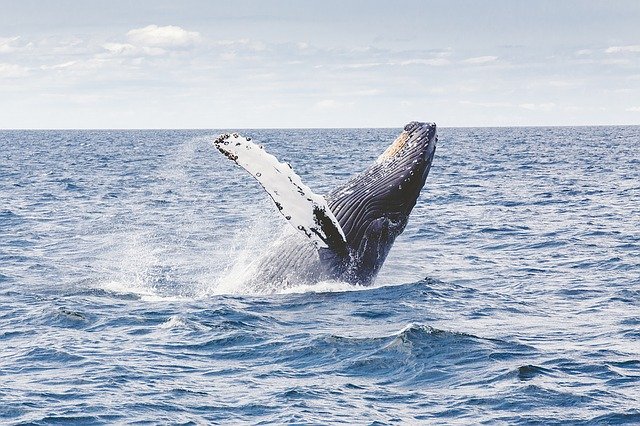
By: Lauren Lomprey (a.k.a The Doodling Nomad)
Reading time: 3-5 minutes
In honor of National Whale Day on February 15th, let’s talk about whales! I am no expert, but I am a lover of whales and they have inspired multiple artworks. My experiences with whales began in 2016 while I was working a summer job in Alaska, on an island off the coast of Seward. Whales were an unexpected part of the job. Being from the desert, we have no whales, so getting to experience them in a wild habitat, quickly became a highlight for me.
Once I left Alaska, I began to implement whale conservation into my business through an organization called Whale and Dolphin Conservation, or WDC for short. This allowed me the opportunity to adopt a whale named Coral! She was a humpback that was off the coast of Maine, that WDC rescued when she was attacked by an orca. WDC focuses on rehabilitating animals when applicable, as well as spreading education about these majestic creatures. As a part of the adoption program through WDC, I am sent quarterly updates about my whale and how she is doing, along with photos and additional whale information. It’s become such a fun experience to be able to track a whale’s life. To learn more about WDC and what they do, head over to us.whales.org, and maybe find a whale to adopt for yourself!
Speaking of tracking whales, did you know that each whale tail is unique? Just as the human fingerprint is unique, scientists can track the whereabouts of whales through observing the patterns on the underside of their tail. This information has greatly aided in tracking the many behaviors of whales. For example, through these observations, scientists have learned that Humpback Whales spend the winter months in the warm waters of Hawaii, then head North for the summer, where they feed on the abundant small prey such as krill, pollock, and various other small fish. Fish are filtered through Humpbacks baleen plates, and they are able to open their mouths really wide, giving them the ability to consume almost 5,000 krill in one day!
Through my experiences in Alaska, I have been able to witness Humpback Whales feeding, and they use various methods. One of the more impressive ways is called Bubble Net Feeding. This is when a group of whales use their strength in numbers and blow bubbles in a shrinking circle. This causes the fish to all gather upward, making it easy for a Humpback to get a large bite!
Another type of whale I have had the pleasure to witness in the wild is a fin whale. Fin whales are the second-largest mammal in the world, and seeing them out at sea is a rarity, as their bodies top out at 74 tons! In order to lunge their bodies out of the water, they have to reach an underwater speed close to 25 mph, which gives the fin whale its nickname of “greyhound of the sea”, as they are often found traveling at speeds faster than a boat. Just like a humpback, a fin whale is a baleen whale, using their baleen mouth plates to consume large amounts of small fish.
Although orcas aren’t technically whales, they are a porpoise, but they deserve an honorable mention. There are two main types of orcas, transient and resident. A transient orca will travel upwards of 1500 miles for living and feeding purposes, while a resident orca will stay within the same 500 miles. There are also major differences in how these animals feed and travel. The easiest way to tell the difference is how big is their “pod”. A transient orca will travel in very small groups of 1-3 and are known for their aggressive eating habits. A transient orca will attack and eat just about anything in the sea and will hunt large mammals such as seals. Resident orcas are quite the opposite. A resident orca can travel in a very large pod, and they follow similar familial ties that humans are accustomed too. As a matriarch centric species, mothers and grandmothers lead the pod. Unlike transient orcas, resident orcas are often found feeding on salmon.
While working in Alaska, I was able to experience orcas up close and personal in the wild. The energy that these creatures carry is palpable. Something unique that I have observed orcas doing is belly rubbing. This is when orcas come up to shore and playfully rub their bellies on the rocks. There are not many locations they have been observed performing this behavior, as it takes a special setting. Ocean water that doesn’t get too shallow too fast and a rocky beach vs. a sandy beach, are a few things an orca might be on the lookout for in order to belly rub. Scientists are unsure of why orcas do this, but some theories include that it is just for fun, or that it’s a way for them to clean themselves.
Being able to have first-hand experience with whales, has put them in a special place in my heart, and it is important we help preserve them. Due to illegal fishing, whaling, destruction to habitats, and captivity practices, whales have dwindled in numbers. With whales such as a gray whale, beluga whale, and the North Atlantic Right Whale being on the endangered species list, it is on us to fight for their survival. Organizations such as the WDC and World Wildlife Foundation (www.worldwildlife.org), fight for the lives of these creatures on a daily basis. To learn ways that you can help in the protection of whales, head over to us.whales.org.
Check out some of my personal photos of Humpbacks and Orcas!
Orca, Eldorado, Male, AK Pod, Fox Island, AK
Orcas, AK Pod belly rubbing on Fox Island, Alaska
Orca, AK12, part of the AK Pod, Fox Island, Alaska
Humpback Whale, Unknown, Cheval Narrows, Alaska
Humpback Whale Bubble Net Feeding, Unknown, Resurrection Bay, Alaska



